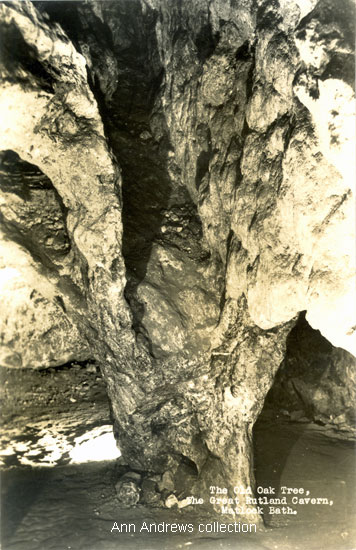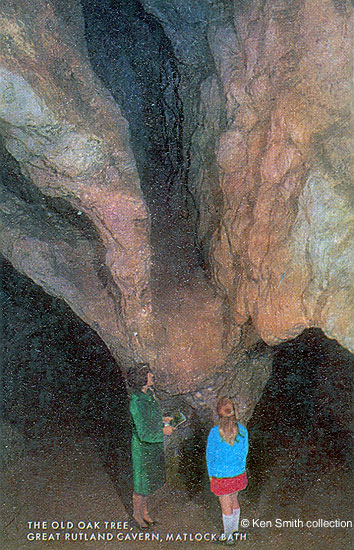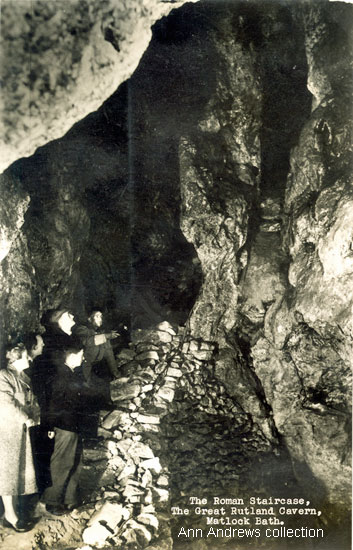|
Images Index> Matlock Bath, 20th and 21st Century Images> This page |
| Matlock Bath: Great Rutland Cavern, Old Oak Tree & Roman Staircase |
| Matlock Bath : Twentieth Century Photographs, Postcards, Engravings & Etchings |
|
||||
The Cavern was opened in 1810[2] and
has been mentioned in every tourist guide about Matlock Bath.
Ebenezer Rhodes wrote, on his third excursion into
Derbyshire in 1818, of visiting Matlock Bath with his friend
Montgomery. The pair ascended the Heights of Abraham, until
they reached the alcove above the trees about half way up
the hill. A shower forced them to shelter, and Montgomery
wrote an impromptu poem on the wall. "On our descent
from the alcove, we passed by the entrance into Rutland Cavern,
a spacious vault in the interior of the mountain, filled
with a variety of crystallizations, intermixed with spars,
and ores of lead, copper and zinc."[3] Llewellynn Jewitt, in 1864, was another to describe the cavern. "The Rutland Cavern, known as the Old Nester Mine, on the Heights of Abraham, approached from the Museum Parade by the roadway by Hodgkinson's Hotel, is the largest in Matlock, and has the advantage of having the finest openings. ... The mine is dry and easily penetrated, and is extremely rich in fossils and minerals. The spars are extremely fine and brilliant[4]". Once Holme Road was built, tourists had an alternative route up to the Lodge, where they would be charged admission for entry to the Heights. Everyone uses the cable car these days. The Old Oak Tree (above) is one of several features within the cavern*; both images date from the 1950s when the Aspey family were the lessees. The people on the coloured postcard help to provide a sense of scale. By 1903, when the image of the Roman Hall (below) was published, the cavern was lit by gas[5]. It was then being advertised by Samuel Sprinthall, whose descendants were still running the cavern in the 1950s. The image itself dates from about 1850[2], however. Interestingly, of the group at the very top of the steps one gentleman is holding a candle aloft, perhaps to show off some of the sparkle in the rocks. Various other people on the steps are peering at the rock surface and a man and woman are standing beside a table at the bottom of the picture. They appear to be studying samples of rocks and minerals displayed on the table and a book is open.
Roman Hall, The Great Rutland Cavern[5]
showing the Roman Staircase and Druid's Altar. 1903 copy of an engraving dating from about 1850[2].
|
||||
1. "The Old Oak Tree, The Great Rutland Cavern, Matlock Bath". No publisher. A real photograph, taken for the lessees 2. "The Old Oak Tree, Rutland Cavern, Matlock Bath" A Salmon CameraColour Postcard, J. Salmon, Ltd., Sevenoaks, 1-19-01-11. Unposted. Postcard in the collection of and provided by and © Ken Smith. 3. Engraving from "Abel Heywood's Guide Books,..." (1903) (see below) 4. "The Roman Staircase, The Great Rutland Cavern, Matlock Bath". No publisher. A real photograph, taken for the lessees Images 1, 2 and 4 in the collection of and provided by and © Ann Andrews. Information researched by and © by Ann Andrews. Intended for personal use only |
||||
|
[1] "The Derby Mercury", 24 July, 1817 - part extract only. The cavern would have been known about locally before it was "discovered". [2] Flindall, Roger and Hayes, Andrew (1976) "The Caverns and Mines of Matlock Bath, 1 The Nestus Mines: Rutland and Masson Caverns", Moorland Publishing Company. [3] Rhodes, Ebenezer (1824) "Peak Scenery" pub. London, Longman, Hurst, Rees, Orme, Brown, and Green, Paternoster Row. [4] ed. Jewitt, Llewellynn "Black's Tourist Guide to Derbyshire" (1864) pub. Adam and Charles Black Edinburgh, pp.233-4 [5] "Abel Heywood's Guide
Books, With Cycling, Walking and Driving Routes. Matlock
Illustrated." (1903) Abel Heywood & Son, Manchester & London. |













 Moore, "Picturesque
Excursions From Derby to Matlock Bath", 1818:
Moore, "Picturesque
Excursions From Derby to Matlock Bath", 1818: